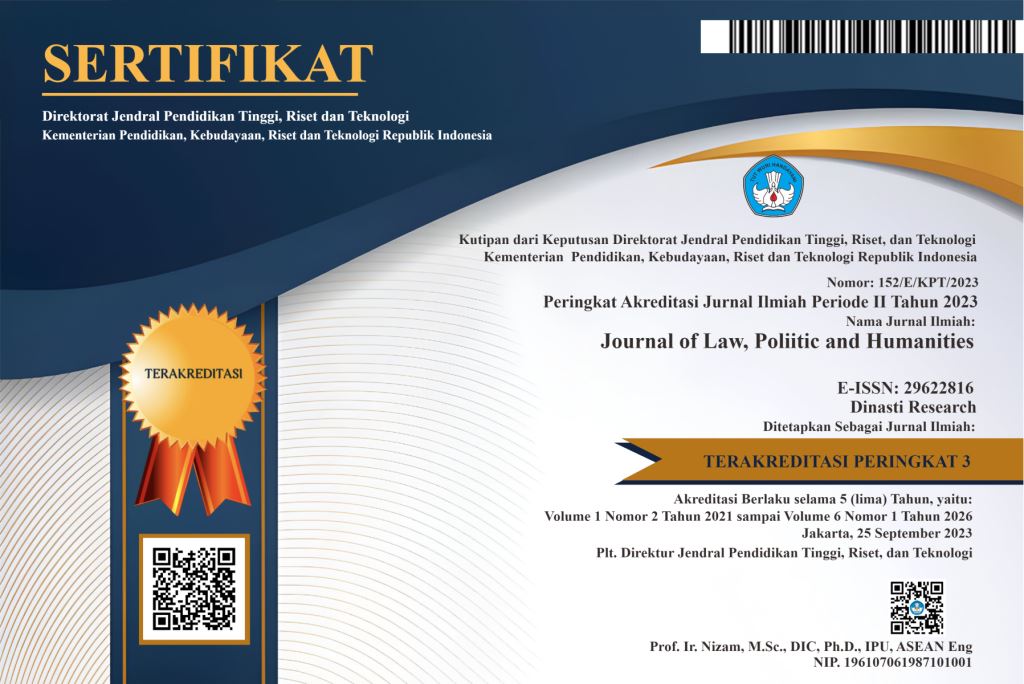Paradigm for the Recruitment of Supreme Court Judges by the House of Representatives is Part of Constitutional Political Intervention
DOI:
https://doi.org/10.38035/jlph.v4i4.394Keywords:
Recruitment Of Supreme Court Justices, Independence, Political InterventionAbstract
The pattern of recruitment of Supreme Court justices which is constitutionally regulated in Article 24A paragraph (3) requires that the nomination of Supreme Court judges is carried out through a nomination mechanism that has been carried out by the Judicial Commission to be approved by the DPR and determined by the President as part of the check and balance concept. However, in such a mechanism it actually confronts a paradigm in which the concept of checks and balances that is presented actually intersects with the concept of independence from the judicial power itself. So by using the literature study or library research method, a conception is obtained that so far the concept of checks and balances has not been placed in the right realm. So that it often creates a problem that intersects one authority with another, including in the realm of the mechanism for the recruitment of Supreme Court justices. So it is important to understand how the conception of Article 24A paragraph (3) is the legal basis for the pattern of recruitment of Supreme Court justices. As well as occupying the concept of the independence of the Judicial Commission in an effort to create accountable supreme justices.
References
Achmad, M. F. dan Y. (2013). Dualisme Penelitian Hukum Normatif Dan Empiris (Cet. Ke-3). Pustaka Belajar. https://mh.umy.ac.id/wp-content/uploads/2016/02/Dualisme-Penelitian-Hukum.pdf
Alamsyah, B. (2010). Kedudukan Dan Wewenang Komisi Yudisial Dalam Sistem Ketatanegaraan Indonesia. Universitas Islam Indonesia.
Alfred Haryanto. (2014). Kewenangan Komisi Yudisial Dalam Pengusulanpengangkatan Hakim Agungsetelah Putusan Mahkamah Konstitusi Nomor 27/PUU-XI/2013 (Vol. 14, Issue 02) [Universitas Andalas]. http://scholar.unand.ac.id/17204/1/DRAF SKRIPSI - Copy.pdf
Andriyan, D. N. (2020). Hukum Kelembagaan Negara. In Hariyanto (Ed.), Paper Knowledge . Toward a Media History of Documents (Cetakan I). CV. Pustaka Ilmu Group Yogyakarta.
BADAN PENGKAJIAN MPR RI. (2017). Checks And Balances Dalam Sistem Ketatanegaraan Indonesia (B. Pengkajian (ed.); Cetakan Pe).
CNN Indonesia. (2022). Survei Indikator: Kepercayaan Publik Pada DPR-Parpol Terus Turun. CNN Indonesia. https://www.cnnindonesia.com/nasional/20220403154457-32-779629/survei-indikator-kepercayaan-publik-pada-dpr-parpol-terus-turun
Diantha, I. M. P. (2019). Metodologi Penelitian Hukum Normatif Dalam Justifikasi Teori Hukum (Cet. Ke-3). Prenadamedia group. https://www.google.co.id/books/edition/Metodologi_Penelitian_Hukum_Normatif_dal/-MpADwAAQBAJ?hl=en&gbpv=1
Faiz, E., Muslih, M., Sahlul, Azhar, I., Mushafi, Z., & Razaq, A. (2013). Risalah Komisis Yudisial: Cikal Bakal, Pelembagaan, dan Dinamika Wewenang. Sekretariat Jenderal Komisi Yudisial Republik Indonesia.
Hiariej, Z. A. M. dan E. O. . (2021). Dasar-Dasar Ilmu Hukum: Memahami Kaidah, Teori, Asas dan Filsafat Hukum (Pertama). Red & White Publishing.
Ihsan, F. H. B. dan A. Y. (2022). Pola Dan Mekanisme Pengisian Jabatan Hakim Agung Pada Mahkamah Agung Republik Indonesia Menurut Sistem Ketatanegaraan Indonesia Berdasarkan Uud 1945. Palar (Pakuan Law Review), 8(2), 374–400. https://journal.unpak.ac.id/index.php/palar/article/view/4309
Indonesia, K. Y. R. (2016). Optimalisasi Wewenang Komisi Yudisial dalam Mewujudkan Hakim Berintegritas. In F. R. H. Hermansyah, Imran, Tri Purno Utomo (Ed.), Optimalisasi kewenangan Komisi Yudisial dalam Mewujudkan Hakim Berintegritas. www.komisiyudisial.go.id
Konstitusi-RI, M. (2015). Putusan Mahkamah Konstitusi Nomor 43/PUU-XIII/2015 (p. 128). http://weekly.cnbnews.com/news/article.html?no=124000
Larasati, A. (2020). Kontestasi Kewenangan Komisi Yudisial Sebagai Element of External Auditor Dalam Proses Rekrutmen Hakim Agung. Jurnal Hukum Lex Generalis, 1(3), 21–38. https://ojs.rewangrencang.com/index.php/JHLG/article/view/258
MPR-RI. (2020). Undang-Undang Dasar Negara Republik Indonesia Tahun 1945. In Sekretariat Jenderal MPR RI (Cetakan Ke, Vol. 23). MAJELIS PERMUSYAWARATAN RAKYAT REPUBLIK INDONESIA.
Muhlizi, A. F. (2013). Melahirkan Hakim Reformis. Rechtsvinding Media Pembinaan Hukum Indonesia, 2(047), 1–7. https://rechtsvinding.bphn.go.id/?page=artikel&berita=3
Mujiburohman, D. A. (2017). Pengantar Hukum Tata Negara (T. S. Press (ed.)). http://repository.stpn.ac.id/510/1/Pengantar-Hukum-Tata-Negara.pdf
Munawir. (2016). Hukum Tata Negara Dalam Bingkai Sejarah Dan Perkembangan Ketatanegaraan di Indonesia. In M. MARTHA ERI SAFIRA (Ed.), CV. Senyum Indonesia (Cet. 1).
Naibaho, R., & Hasibuan, I. J. M. (2021). Peranan Mahkamah Agung Dalam Penegakan Hukum Dan Keadilan Melalui Kekuasaan Kehakiman. Nommensen Journal of Legal Opinion, 2(02), 203–214. https://doi.org/10.51622/njlo.v2i02.388
Prasetianingsih, R. (2016). Akuntabilitas Kekuasaan Kehakiman. Jurnal Konstitusi, 8(5), 829. https://jurnalkonstitusi.mkri.id/index.php/jk/article/download/858/188/372
Puspitasari, S. H. (2018). Pelibatan Dewan Perwakilan Rakyat Dalam Pengisian Jabatan Hakim Agung Dan Hakim Konstitusi. Jurnal Hukum Ius Quia Iustum, 25(3), 427–449. https://journal.uii.ac.id/IUSTUM/article/view/11279/8852
Rahmatullah, I. (2013). REJUVINASI SISTEM CHECKS AND BALANCES DALAM SISTEM KETATANEGARAAN DI INDONESIA. Jurnal Cita Hukum, 1(2), 12. https://doi.org/2356-1440
Rakyat, M. P. (2010). Naskah Komprehensif Perubahan Undang-Undang Negara Republik Indonesia Tahun 1945 (Latar Belakang, Proses, dan Hasil Pembahasan 1999-2002) (Edisi Revi). Mahkamah Konstitusi. https://mkri.id/public/content/infoumum/naskahkomprehensif/pdf/naskah_Naskah Komprehensif Buku 2.pdf
Rishan, I. (2016). Relasi Kekuasaan Komisi Yudisial-Dewan Perwakilan Rakyat Dan Presiden Dalam Rekrutmen Hakim Agung. Journal Maranatha: Universitas Kristen Maranatha, 1(1), 1–20. https://journal.maranatha.edu/index.php/dialogia/article/view/716/712
Sidin, A. I. (2017). Konstitusionalitas Kewenangan Komisi Yudisial Dalam Proses Seleksi Pengangkatan Hakim. Jurnal Ketatanegaraan, 004(10), 233–258. https://www.ptonline.com/articles/how-to-get-better-mfi-results%[email protected]
Subiyanto, A. E. (2012). Mendesain Kewenangan Kekuasaan Kehakiman Setelah Perubahan UUD 1945. Jurnal Konstitusi, 9(4), 665–667. https://jurnalkonstitusi.mkri.id/index.php/jk/article/download/944/148
Tutik, T. T. (2012). Pengawasan Hakim Konstitusi Dalam Sistem Pengawasan Hakim Menurut Undang-Undang Dasar Negara RI 1945. Jurnal Dinamika Hukum, 12(2), 17. https://doi.org/10.20884/1.jdh.2012.12.2.51
Ulya, Z. (2016). Pembatalan Kewenangan Komisi Yudisial Dalam Rekrutmen Hakim Dikaitkan Dengan Konsep Independensi Hakim (Studi Putusan Mahkamah Konstitusi Nomor 43/PUU-XIII/2015). MIMBAR HUKUM, 28(3), 482–496. https://jurnal.ugm.ac.id/jmh/article/view/16686
Undang-Undang Nomor 18 Tahun 2011 Tentang Perubahan Atas Undang-Undang Nomor 22 Tahun 2004 Tentang Komisi Yudisial, Pub. L. No. 18, JDIH BPK-RI 26 (2011).
Undang-Undang Nomor 22 Tahun 2004 Tentang Komisi Yudisial, Pub. L. No. 22, 23 (2004).
Undang-Undang Nomor 3 Tahun 2009 Tentang Perubahan Kedua Atas UNDANG-UNDANG NOMOR Undang-Undang Nomor 14 Tahun 1985 Tentang Mahkamah Agung, Pub. L. No. 3, 27 (2009).
Downloads
Published
How to Cite
Issue
Section
License
Copyright (c) 2024 Nazhif Ali Murtadho

This work is licensed under a Creative Commons Attribution 4.0 International License.
Authors who publish their manuscripts in this journal agree to the following conditions:
- The copyright on each article belongs to the author(s).
- The author acknowledges that the Journal of Law, Poliitic and Humanities (JLPH) has the right to be the first to publish with a Creative Commons Attribution 4.0 International license (Attribution 4.0 International (CC BY 4.0).
- Authors can submit articles separately, arrange for the non-exclusive distribution of manuscripts that have been published in this journal into other versions (e.g., sent to the author's institutional repository, publication into books, etc.), by acknowledging that the manuscript has been published for the first time in the Journal of Law, Poliitic and Humanities (JLPH).


























